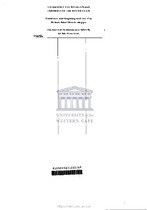| dc.contributor.advisor | Maree, Johann (UCT) | |
| dc.contributor.advisor | Le Roux, Peter (UWC) | |
| dc.contributor.author | Lomofsky, Dena | |
| dc.date.accessioned | 2021-02-22T11:07:55Z | |
| dc.date.available | 2021-02-22T11:07:55Z | |
| dc.date.issued | 1997 | |
| dc.identifier.uri | http://hdl.handle.net/11394/7857 | |
| dc.description | Magister Artium (Development Studies) - MA(DVS) | en_US |
| dc.description.abstract | The objective of this research is to investigate the factors at plant level which impact on the diffusion of Japanese Manufacturing Techniques to enterprises in developing countries generally, and South Africa specifically. This informs the development of meaningful supply-side measures to improve the competitiveness of South African manufacturers. This has been achieved through both a thorough examination of the literature and through field research. The field research documents the implementation experiences in fifteen South African plants which participated in the Shopfloor Best Practice workshops of the Manufacturing Roundtable (MRT). I chose to examine these examples of transfer as I was a participant researcher, attached to the MRT. The central question which guided my research is what are the factors which affect the depth of systemic adoption of Japanese Manufacturing Techniques on the shopfloor in South Africa, and what this indicates for the breadth of diffusion of the techniques across the manufacturing sector as a whole. The research argument is that for sustainable adoption both social and technical aspects of Japanese Manufacturing Techniques need to be addressed. Focusing on the technical aspects only and presenting a universally applicable model obscures the realities of transfer, as the embeddedness of the techniques in the social and institutional context is ignored. The point of departure for analysis in this thesis is thus real examples of transfer, as opposed to a
universally defined and abstracted model. The experience and opinions of the workshop participants, and those of managers in their plants, have been gathered through individual in-depth interviews and site visits. The evidence indicates that there are many factors both internal and external to the firm which are likely to constrain significantly the ability of some firms to move in the systemic direction. These include the poor primary education of much of the workforce, poor management skills, wage and social inequality and a lack of participation in the workplace. It becomes apparent that the process of diffusion amongst South African manufacturers is not likely to be rapid or steady, and that the most likely path is one of uneven diffusion. | en_US |
| dc.language.iso | en | en_US |
| dc.publisher | University of the Western Cape | en_US |
| dc.subject | Japanese Manufacturing Techniques | en_US |
| dc.subject | Manufacturing Roundtable (MRT) | en_US |
| dc.subject | South African manufacturers | en_US |
| dc.subject | Developing countries | en_US |
| dc.subject | Workplace Challenge | en_US |
| dc.subject | Best Practice Initiative (BPI) | en_US |
| dc.title | Does the Emperor have any clothes? The diffusion of Japanese Manufacturing Techniques to Enterprises in South Africa | en_US |
| dc.rights.holder | University of the Western Cape | en_US |

